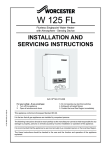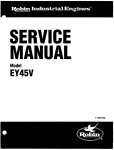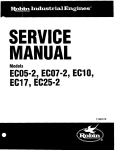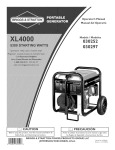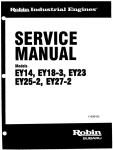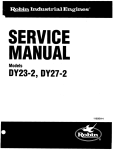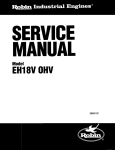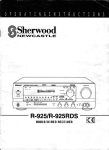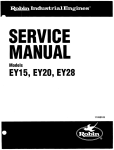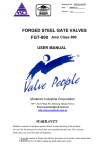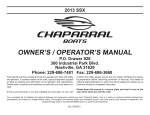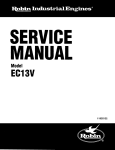Download Robin America EY44-2 Specifications
Transcript
ROBIN AMERICA, INC. ROBIN TO WISCONSIN ROBIN ENGINE MODEL CROSS REFERENCE LIST ROBIN WISCONSIN ROBIN SIDE VALVE EY 08 EY15 EY 15V EY20 EY20V EY23 EY28 EY35 EY40 EY45V EY2 1 EY44 EY 18-3 EY25 EY27 W 1-080 WI-145 W1-145V W1-185 W1-185V W 1-230 W 1-280 Wl-340 W1-390 W 1-450V EY21W EY44W EY 18-3W EY25W EY27W v EH11 EH12 EH15 EH17 EH2 1 EH25 EH30 EH30V EH34 EH34V EH43V WO1-115 wo1-120 WO1-150 WO1-170 wo1-210 WO 1-250 WO 1 -300 WOI-3oov WO 1-340 WO1-340V WO 1-43OV TWO CYCLE EC13V WT1-125V DIESEL DY23 DY27 DY30 DY35 DY4 1 WRD 1-230 WRD 1-270 WRD1-300 WRD1-350 WRD1-410 CONTENTS Section Title . Page 1 SPECIFICATIONS ............................................ 1 2. PERFORMANCE ............................................ 2 2.1 . 2.2 . 2.3 . Maximumoutput . . . . . . . . . . . . . . . . . . . . . . . . . . . . . . . . . . . . . . . Continuous Rated Output . . . . . . . . . . . . . . . . . . . . . . . . . . . . . . . . . Maximum Torque and Fuel Consumption Ratio a t Max Output . . . . . . . . . 3. FEATURES ............................................... 4 . GENERALDESCRIPTION 4.1 . 4.2 . 4.3 . 4.4 . 4.5 . 4.6 . 4.7 . 4.8 . 4.9 . 4.10 . 4.11 . 4.12 . 4-13. 4- 14 . 4.15 . 4- 1 6 . 5.5 . 5.6 . . . 6-3. 3 4 4 6 6 6 6 6 6 6 6 7 7 7 7 7 7 7 ............................................ 8 Mounting . . . . . . . . . . . . . . . . . . . . . . . . . . . . . . . . . . . . . . . . . . . . Ventilation . . . . . . . . . . . . . . . . . . . . . . . . . . . . . . . . . . . . . . . . . . . Exhaust Gas Evacuation Fuel System Power Transmission to Driven Machines Wiring 8 8 8 8 .................................. .......................................... ....................... .............................................. 6 DISASSEMBLY and REASSEMBLY 8 1 6-2. ............... Sectional View of Engine . . . . . . . . . . . . . . . . . . . . . . . . . . . . . . . . . . Crankcase . . . . . . . . . . . . . . . . . . . . . . . . . . . . . . . . . . . . . . . . . . . Main Bearing Cover ..................................... Crankshaft . . . . . . . . . . . . . . . . . . . . . . . . . . . . . . . . . . . . . . . . . . . ConnectingRod and Piston . . . . . . . . . . . . . . . . . . . . . . . . . . . . . . . . Camshaft ........................................... Cylinder and Cylinder Head . . . . . . . . . . . . . . . . . . . . . . . . . . . . . . . Valve Arrangement ..................................... Balancer . . . . . . . . . . . . . . . . . . . . . . . . . . . . . . . . . . . . . . . . . . . . . Governor . . . . . . . . . . . . . . . . . . . . . . . . . . . . . . . . . . . . . . . . . . . . . Cooling . . . . . . . . . . . . . . . . . . . . . . . . . . . . . . . . . . . . . . . . . . . . . Lubrication . . . . . . . . . . . . . . . . . . . . . . . . . . . . . . . . . . . . . . . . . . . Ignition . . . . . . . . . . . . . . . . . . . . . . . . . . . . . . . . . . . . . . . . . . . . . Carburetor . . . . . . . . . . . . . . . . . . . . . . . . . . . . . . . . . . . . . . . . . . . Air Cleaner . . . . . . . . . . . . . . . . . . . . . . . . . . . . . . . . . . . . . . . . . . . Selenium Rectifier . . . . . . . . . . . . . . . . . . . . . . . . . . . . . . . . . . . . . . 5.lNSTALLATlON 5.1 . 5.2 . 5.3. 5.4 . of ENGINECONSTRUCTION 2 2 2 .............................. Preparations and Suggestions ............................... SpecialTools . . . . . . . . . . . . . . . . . . . . . . . . . . . . . . . . . . . . . . . . . DisassemblyandReassemblyProcedures ....................... 8 9 10 10 10 11 7 . MAGNETO 7.1 . 7.2 . 7.3 . 7.4 . ............................................... 18 Magneto . . . . . . . . . . . . . . . . . . . . . . . . . . . . . . . . . . . . . . . . . . . . . Breaker PointAdjustment . . . . . . . . . . . . . . . . . . . . . . . . . . . . . . . . . Timing Adjustment ..................................... Magneto Service Instructions . . . . . . . . . . . . . . . . . . . . . . . . . . . . . . . 18 18 18 8. GOVERNOR ADJUSTMENT 9.CARBURETOR ................................... ............................................. 19 21 22 Operation and Construction . . . . . . . . . . . . . . . . . . . . . . . . . . . . . . . . 22 Disassembly and Reassembly . . . . . . . . . . . . . . . . . . . . . . . . . . . . . . . . . 23 Adjustment . . . . . . . . . . . . . . . . . . . . . . . . . . . . . . . . . . . . . . . . . . 23 9.1 . 9.2 . 9.3 . . 11. TROUBLESHOOTING 10 RUN-INOPERATION 11.1 . 11.2 . 11.3 11.4 . 11.5 . 11.6. . OF ENGINE after REASSEMBLY ............... ....................................... StartingDifficultes . . . . . . . . . . . . . . . . . . . . . . . . . . . . . . . . . . . . . . EngineMisses ......................................... EngineStops . . . . . . . . . . . . . . . . . . . . . . . . . . . . . . . . . . . . . . . . . . Engine Overheats ...................................... EngineKnocks ........................................ EngineBackfiresThroughCarburetor ......................... 25 26 26 27 27 27 28 28 . . . . . . . . . . . . . . . . . . . . . . . . . . . . . . . . . . . 29 13. MAINTENANCE and STORING . . . . . . . . . . . . . . . . . . . . . . . . . . . . . . . . . 35 12 CHECKS and CORRECTIONS . 13.1 13.2 . 13.3 . 13.4 13.5 . 13.6 13.7 . . . . . . . . . . . . . . . . . . . . . . . . . . . . . . . . . 35 . . . . . . . . . . . . . . . . . . . . . . . 35 Daily ChecksandMaintenance Every20HoursChecksandMaintenance Every 50 Hours (10 days)ChecksandMaintenance Every 100-200 Hours (Monthly) ChecksandMaintenance Every 500-600 Hours(Semianual)ChecksandMaintenance Every1000Hours (Yearly) ChecksandMaintenance ............... Preparation for Long Abeyance . . . . . . . . . . . . . . . . . . . . . . . . . . . . . . . . . . . . . . . . . . . . . 35 . . . . . . . . . . . 35 .......... 36 36 36 1. SPEC1 FICATIONS -1- 2. PERFORMANCE 2-1MAXIMUMOUTPUT The maximum output of an engine is such standard power as developed by that engine, after its initial run-in period witha1 the moving parts properly worn-in, when operating with the fully open throttle valve. Therefore, it follows that enginemaynotdevelopthismaximumoutputinthebeginning,becausemovingpartsarenot in aproperly a nev w0rn-h condition. 2-2 CONTINUOUSRATEDOUTPUT The continuous rated output of an engine is such power as developed by that engine when running at an optimum speec most favorable from the point of view of engine life and fuel consumption ratio. Therefore, it follows that when designing i EY33-2 or EY44-2 engine, as a primemover,thecontinuouspowe driving systemforanymechanism,withamodel requirement of that mechanism must be kept below the continuous rated output specified. 2-3 MAXIMUM TORQUE AND FUEL CONSUMPTION RATIO AT MAX. OUTPUT The maximum torque of an engine is that driving torque of the driving shaft at which the engine is driving an external load while the engine is developing its max. output. The fuel consumption ratio at max. output is that fuel consumption ratio o an engine while that engine is running at the max. output. PERFORMANCECURVE Model EY33-2 ( )for B type RECOMMENDED OPERATING SPEED RANG a I 7 HP 5 M A X . TORQUE 125112 5 I 124)12 1.7(3.4) -I -~ 1.6(3.2) ft"b (23J11.5-- I kg-rn 1.5 ( 3 . 0 ) 320 300 280 2000 (1OOO) 3500 - 3000 2500 112501 115001 rpm -2- 11750) g/ P.h 3. FEATURES 1. A compact, lightweight, and highly durable 4cycle aircooled EYseries with high output, embodying ingenious design and advanced machining techniques. 2. 3. Simple construction, good appearance, plus easy start-up. Smooth speed control functions of governorguaranteesstableoperationundervariousloadconditionsoverawide range of applications. 4. Economical advantage with minimized fuel consumption. 5. Since power can be taken in any direction simply by pulling the belt, and the feed and drain oil work can also be done easily in two directionsof engine, the engineis easily coupled with operating machines. 6 . The use of dynamic balancer reduces vibrations to such an extantas in a two-cylinder engine. PERFORMANCE CURVE Model EY44-2 ( ) f o r B type R E C O M M E N D E D O P E R A T I N G SPE 11 10 HP 9 0 7 6 (33) 16.5 2.3(4.6) (32) 16 2.2(4.4) (31) 15.5 2.1(4.2) tt-lb 2000 2500 3000 (1000) (1250) (1500) m p-r -J- 3500 (1750) kg-m /- FLYWHEEL(COOLI~GFAN) I \ LIGHTING COIL CRANKCASE -4 - SEl -5- 4-2 CRANKCASE The crankcase is made of aluminum die-cast and separable on driving shaft side with main bearing cover assembled. Provided on blower side are two ball bearings, each supporting the crankshaft and camshaft. 4-3 MAINBEARING COVER The aluminum die-cast main bearing cover on the driving shaft side allows easy access to the engine interior for inspection simply by removing it. The’fange and boss permit direct coupling of operating machines such as generators, pumps, etc. The oil inlets whichalso serve as oil gauges can be mounted on driving shaft side of Models EY33-2B and E Y 4 4 - 2 B . The force-fit balancer shaft and balancer holder mounting boss assure easy mounting of the balancer mechanism. 4 4 CRANKSHAFT The crankshaft is machined from carbon steel forging with an induction hardened crank pin. The breaker cam is provided on blower side, while crankshaft gear and balancer gear are force-fit on driving side. 4-5 CONNECTING ROD and PISTON The connecting rod is machined from aluminum alloy forging, and forged alloy itself serves as bearing metal at both ends. (Model EY44-2 employs aluminum metal on the large end.) An oil scraper is provided on the large endforthepurpose ofsplashinglubricatingoil.Thepiston is machinedfron aluminum alloy casting and provided with grooves for two compression rings, one oil rings, and one skirt ring. The EY44-2 piston has an offset structure at the piston pin center so as to reduce striking sound of piston. 4-6 CAMSHAFT Thecarbonsteelforgingcamshaftincorporatesintegralintakeandexhaustcamsplusaforce-fitcamgear. The B-typ camshaft also serves as driving shaft and it is driven at half the crankshaft speed. 4-7 CYLINDER and CYLINDERHEAD The cylinder is made of special cast iron and provided with many fins for assuring excellent cooling effects. The cylinda head is made of aluminumalloycasting.TheRicardotypecombusionchamberwithasufficientareaassures hil combusion efficiency. The spark plug is tilted to facilitate fuel tank mounting. 4-8 VALVEARRANGEMENT Theexhaust valve is positioned in theupstreamofthecolling air so thatit is intensivelycooled downforimprov durability of engine. 4-9 BALANCER An unbalanced inertia force produced due to crankshaft and piston connecting rod in the vertical and lateral direction: balanced bybalancerwhichrotatesat a ratioof 1: 1 in the direction opposite to crankshaft, unbalanced inertia force are reduced. -6- so that vibrations due 4-10 GOVERNOR The centrifugal flyweight type governor assures constant-speed operation at selected speed, irrespective of load fluctuations. 4-11 COOLING The cooling fan which also serves as a flywheel forcily feeds cooling air to the cylinder head with the aid of cylinder baffles and head cover. 4-12 LUBRICATION Therotatingand slidingpartsarelubricatedbyscoopingandsplashingoilincrankcasewith oil scraperattachedto connecting rod. 4-13 IGNITION The ignition system is of flywheel magneto type with ignition timing set at 23' before TDC. The magneto is composed of a flywheel,anignitioncoil,abreaker,andlighting(charging)coil.Theflywheel(servingalso as afan) is mountedon crankcase, while the other elementsare directly assembled in crankcase (For details, refer to the MAGNETO section). 4-14 CARBURETOR A horizontaldraftcarburetor is employed.Itssettinghasbeencarefullyafterthoroughteststoachievebeststart-up, acceleration, fuel consumption, output, and other performance. For other details, see the CARBURETOR section. 4-15AIRCLEANER An impinge type semi-wet air cleaner catches dust particles in the air by means of felt in dust case. The air is then cleaned by passing through a filter element. 4-16SELENIUMRECTIFIER The selenium rectifier serves to rectify the AC current generated by AC charging coil of magneto into DC current to charge battery when a starting motor is combined. -7- 5. INSTALLATION Since the installation method affects the service life, ease of maintenance, frequency of check and reapir, and operating costs of engine, the following contents should be carefully examined before installing your engine. For details, referto the separate “SALES MANUAL”-Engineering Information-. 5-1 MOUNTING When installing the engine, its mounting position, coupling conditions with operating machines, and anchoringor supporting methods must be carefully examined. Particularly when determining its mounting position, due care should be taken to assure the convenience of such routines as replenishment and checking of fuel and oil, checking of spark plug and breaker points, maintenance of air cleaner, and oil drainage. 5-2 VENTILATION The engine must be supplied with .fresh air for cooling and fuel combustion. If engine is operated with a cover or in a small room, the engine room is heated, causing vapor lock, deterioration of oil, increase of oil consumption, power reduction, no longer. seizure, loss of engine life, and thus proper engine operation can be expected It is therefore necessary to provied a cooling air duct and a baffle plate for the purpose of preventing insufficient circulation of heated air after cooling engine and or temperature-rise of operating machines. The temperature of engine compartment should be kept below 4OoC even in mid-summer. 5 3 EXHAUST GAS EVACUATION Since the exhaust gas from engine is toxic, it must be exhausted outside if engine is operated indoors. As the output power of an engine is considerably influenced by the length of exhaust duct, its diameter must be increased in proportion to its length. 5-4 FUELSYSTEM When fuel tank is separated from engine, it must be located so that its bottom surface lies within 5-50cm (2”-20”) above the fuel joint of carburetor. If the fuel tank is installed too low, fuel is not fed properly, and if it is too high, the carburetor may overflow. For fuel piping, carefully examineit for heat conductivity, diameter, bending, andleakage through fittings so as to eliminate air lock and vapor lock. It is recommended to minimize piping length. The standard ID of fuel pipe is 4-5mm (5,2”-13/64“). 5-5 POWER TRANSMISSION to DRIVEN MACHINES 5-5-1 BELT D R I V E Be carefulwiththefollowing items. *Ilse a V-belt rather than a flat belt. *Set the driving shaft of engine and the driven shaftof driven machine in paralled with each other. *Align the driving pulley of engine and the driven pulley of driven machine correctly with each other. *Mount the driving pulley as nearer to the engine as possible. -8- 5-6 WIRING a JIS CB104 female terminal -e JIS CA104 male terminal -@ - JIS LA 104 or LA108 plate terminal The dotted parts are not supplied with the engine. " " " 5-6-1 ROPE STARTINGENGINE MAGNETO _"" . '-N / BUZZER (6"- 8 W ) SPARKPLUG Fig. 5-6-1 LAMP (12V. 15W) 5-6-2 ENGINEwithSTARTINGMOTOR MAGNETO LA 104 -g -: 6. DISASSEMBLY and REASSEMBLY 6-1 PREPARATIONS and SUGGESTIONS 1 ) When disassembling engine, carefully note mounting positions and methods of respective parts in order to be able to reassemble them correctly. Tag parts, if there is a possibility of confusion. 2 ) Prepare several boxes to keep parts belonging to respective groups together. 3 ) In order to prevent missing or misplacing, group related parts together, tentatively assembling them immediately after disassembling each sub-assembly. 4 ) Carefully handle parts, and clean them with washing oil after disassembling. 5 ) Use correct tools in correct ways. 6 ) Standard tools to be prepared for disassembling. a) b) Work Bench ' Washing Pan c) Disassembling Tools d) Washing Oil (Kerosene or Gasoline), Mobile Oil e)EmeryPaper,Cloth 7 ) Drain fuel and oil without fail before disassembly. To drainoil,unscrewtheoildrainpluglocatedonthesideofcrankcaseoncarburetorsidebyturningit counter-clockwise. 8 ) Clamp cylinder head, cylinder main bearing cover, connecting rod, spark plug, and flywheel with specified torque when reassembling them. 9 ) Replace all the packings and gaskets with new ones when reassembling. I O ) Wash parts with new gasoline o r washing oil, and blow them with compressed air before reassembling. 1 1 ) Apply mobile oil to the rotating and sliding parts. 12) Be careful not to contaminate parts with dust during reassembling. 13) Tighten bolls, nuts, and screws to correct torque readings specified. I f small screws are tightened too strongly, they may be broken. signs of abnormal friction, noises, or looseness. 14) After reassembling, turn the moving parts by hand, and check them for 6-2 SPECIALTOOLS .. . "" c" " - ." -.. ~ " " 3 " V A L V E SPRING COMPRESSOR Fig. 6-2 -1 0- I 209 99010 07 (Y790-350) 001 65085 00 Flywheel Puller Bolt I 1 Valve Spring Compressor 209 9901 1 07 (Y790-282) Valve Seat Cutter (45”) 209 9901 2 07 1 (H640-118) 1 Pilot Stem 6-3 DISASSEMBLY and REASSEMBLYPROCEDURES 6-3-1 FUEL TANK and TANK BRACKET 1) Disconnect fuel pipe between fuel strainer and carburetor from carburetor. 2) Detach fuel tank from its mounting bracket (8mm nut X 4). 3 ) Detach bracket and head cover from cylinder head (8mm bolt X 2). In reassembly; It is recommended to replace fuel pipe with new one before reassembly. CAUTION: REPLACE FULE PIPE WITH NEW ONE ONCE EVERY YEAR. 6-3-2 BLOWER HOUSING and CYLINDERBAFFLE 1) Disconnect primary coil wire from stop button wire. 2 ) Take off muffler cover and blower housing from crankcase. and baffle from cylinder head. (6mm bolt 3) X 36mm screw X 4). Remove baffle from cylinder block. (6mm screw . 6-3-3 X 2). AIRCLEANER 1) Remove air cleaner cover and element. 2) Detach bottom plate of air cleaner from carburetor by loosening two 6mm bolts. (Also, detach the choke button from the carburetor chocke lever) 3) Disconnectbreatherpipe. In reassembly; Put air cleanerelement in gasolineandsufficientlywashitwhileshakinguntildust is completelyremoved.After oil (gasoline and mobile washing, dry the element thoroughly and apply mixture of 4:1), before oil mixed at a ratio reassembly. 6-3-4 MUFFLER Remove muffler from cylinder part of crankcase (8mm nut 6-3-5 GOVERNORLEVER 1)Detachgovernor X 2, 8mm bolt X 2). and CARBURETOR lever fromgovernorlevershaft(6mmnut X 1 ). 2) Detachgovernorrodandrodspringfromcarburetor. 3) Removecarburetorfromcylinder par‘t of crankcase (EY33-2: 6mmnut In reassembly: Referto “8. GOVERNOR ADJUSTMENT”section. -1 1- X 2 , EY44-2: 8mmnut X 2). 6-3-6 STARTING PULLEY and FLYWHEEL (magneto) Remove 3 piecesmountingboltstodetachstarting pulley from flywheel. Remove flywheel from crankshaft. nut,and 18mm or box wrench into an Insert a socket wrench give thewrenchasharpblowwithasoft hammer. Remove nut and spring washer. AttachflywheelpullertoflywheelasshowninFig. 6-3-1, andturncenterboltclockwiseuntilflywheel becomes loose enough to be removed. Disconnecthightensioncable of ignitioncoilfrom Fig. 6-3-1 disconnect crankcase, plug, spark from clip cable and then, remove ignition coil from crankcase (6mm X 25mm screw X 2). Remove cable clip from lighting coil cable, and detach lighting coil from crankcase (6mm X 30mm screw x 2). Remove breaker cover, and then remove contact breaker and condenser from crankcase. In reassembly ; Refer to “7-2 BREAKER POINT ADJUSTMENT” and “7-3 TIMING ADJUSTMENT”. 6-3-7 CYLINDERHEAD 1) and SPARKPLUG Detach spark plug from cylinder head. 2) Detach cylinder head and gasket from cylinder by loosening lOmm nut. In reassembly; 1) Remove carbon from combustion chamber and also remove dirt from the vicinity of cooling fins of cylinder head. Check head face for distortion. Replace cylinder head, if needed. 2)Replacegasketwithnew 3) one. Clamping torque of cylinder head is 450-500 kg-cm (32.5-36 ft-lbs). NOTE: Leavespark plug detached temporarily to facilitate engine rotation during timing adjustment. When mounting finally, tighten it 250-300 kg-cm (18-21.7 ft-lbs). 6-3-8 INTAKE and EXHAUST VALVE Detachinnerandoutertappet cover fromcylinder block (6mm bolt x 2). Detach retainer locks and valves by Lifting valve spring using a valve spring retainer. Proceed bothforintake valve andexhaust in the same way valve. (Fig. 6-3-2) Then, remove valve springs and spring retainers. CA 1JTION: TAPPET DO NOT DAMAGE GASKET SURFACE OF C H A M B E R WITH THE COMPRESSOR TOOL. Fig. 6-3-2 - 1 2- - In reassembly; 1) Clean carbon and gum deposits from the valves, seats, ports and valve stem holes. 2) Replace valves, if badly burned, pitted or warped. 3) Correct the valve seat by using 45" seat cutter tool as illustrated in 1.2-1 S m m (.04-.05 4) Fig. 6-3-3. The seat should be finished to inch) in width. Cylinderblockshouldbereplaced if valve stemclearancebecomesexcessive.'Referto Fig. ..-' 4 for clearance specifications and proper assembly. After correcting valve seats, lap valves in place until a uniform ring 5) a hotsolution valve. Clean valves, andwashblockthoroughwith will show entirely around the face of soapandwater. of the Wipecylinderwalls with clean lint free rags and light engine oil. CAUTION: DO N O T ASSEMBLE V A L V E SPRINGS ANDSPRINGRETAINERS AFTER ADJUSTING TAPPET CLEARANCE. Fig. 6-3-3 VALVE and VALVESTEMHOLECLEARANCE 4 5" A - VALVE FACE ANGLE I I I I B - SEAT ANGLE - (::!;::) 8 DIA. +:.036 INTAKE 8 DIA. -0 0 3 0 -0:oss ( 3168' :313rr) EXHAUST 8 DIA. ;:1 ( ::fi::) INTAKE 0.030-0.09 1 (.0012"-.0036") EXHAUST 0.090-0.146 C - GUIDE INSIDE DIA. D 45" VALVE STEM DIA. MAXIMUMALLOWABLE CLEARANCE BETWEEN C a n d D Fig. 6-3-4 -1 3- (.0035"-,0057") I 6) ADJUSTING TAPPET CLEARANCE (Fig. 6-3-5) * Rotate crankshaft until tappet position,hold is in its lowest valve downandinsertfeelergauge between valve andtappetstem.Theclearancefor both intake and exhaust, with engine cold. 0.13-0.17mm * (0.0051”to 0.0067“) If clearance is less than specified, slightly grind valve stem and measure it again. * If clearance is largerthanspecified,sink valve seat to adjust clearance. * Afterclearanceadjustment,assemble valvesprings in placewith and valve retainers, and secure them retainerlocks.Checktappetclearance Fig. 6-3-5 again for proper adjustment by turning crankshaft. 6-3-9 CYLINDER BLOCK Detachcylinderbylooseningone8mmandfivelOmm nuts. In reassembly; Remove from upper surfaceof cylinder, carbon deposit R I N G GUIDE HOLDER \ which otherwise may damage piston when piston moves. lnsert doubling a plate between piston skirt and crankcase, and set piston to the cylinder center so that piston will not move easily. (Fig. 6-3-6). . Stagger the piston ring gaps 90° apart around piston. Apply oil to piston ring and cylinder walls sufficiently. :~ 1 ; d Fig. 6-3-6 NOTE: Use new cylinder gasket. 5) Check if piston moves smoothly after reassembly. Clamping torque of cylinder is as shown below. 8mm nut 170-190 k g c m (12.3-1 3 . 7 ft-lbs.) lOmmnut350-400kg-cm (25.3-29 MAIN BEARING COVER ft-lbs.) 6-3-70.MAINBEARING COVER I) Unscrew 6mmboltlocated drivingshaftside just belowcrankshafton of mainbearingcoverand 8 pieces bolts for mounting main bearing cover. 2)Aftersettingcrankshafttotheupperdeadpoint piston, insert a 4mm rod through 6mm screw of hole t o fix crankshaft as shown in Fig. 6-3-7. Then, evenly tap aroundtheperipheryofbearingcoverwithasoft Fig. 6-3-7 hammer until cover breaks free from crankcase. CAUTION: BE CAREFUL NOT TO DAMAGE OIL SEA 1. ”14- In reassembly; 1)Whenreassemblingmainbearingcover,assemblegovernorlevershaftandgovernorarmbeforereinstallingthem into crankcase. NOTE: If replacement of oil seal is required, force-fit new oil seal before reassembly. 2) When reassembling main bearing cover, apply oil to bearing surfaces, gear train, tappets, and oil seal lips, and form a thin film of oil o n main bearing cover face. Mount an oil seal guide onto .crankshaft to prevent damage t o oil seal lips. NOTE: Turn crankshaft to TDC, and lock the balancer driven gear by inserting a 4mm dia. rod thru the plug hole and Into a hole in the balancer driven gear (Fig 6-38) 3) Check if side clearance of crankshaft is 0"0.2mm, and adjust it using adjusting collar, if needed. 4) Clamping torque of mounting bolts for main bearing coveris 170-1 90 kg-cm ( 1 2.3-1 3.7 ft-lbs.). \ T J O W C l ? . > n O n D * TIMING MARK CAMSHAFT Fig. 6-3-9 6-3-11 1) CAMSHAFT and TAPPET To prevent tappets from falling out and being damaged when camshaft is removed, turn crankcase over on its side as shown in Fig. 6-3-9. Push tappets inward to clear cam lobes, and remove camshaft. 2) Withdrawtappets. NOTE: Mark them so that they can be reinstalled in the same holes. In reassembly; 1) Put tappets back in their corresponding hole first and then mount camshaft. CAUTION: DON'T FORGET TO MOUNT GOVERNOR SLEEVEON CAMSHAFT. 2) Timing marks on camshaft gear and crankshaft gear must be matched up. If valve timing is off, engine will not func:tion properly or may not run atall. NOTE: Mount camshaft so that the marked tooth on crankshaft gear is between the two marked teeth of the camshaft gear. (Fig. 6-3-9) 6-3-12CONNECTING ROD and PISTON 1) Straighten out the bent tabsof rod lock washer and remove bolts from connecting rod. 2) Remove oil scraper, lock washer and connecting rod cap from crankshaft. 3) Remove piston from connecting rod by detaching two clips, and then removing piston pin. 4) Remove piston rings from piston by widening open ends. -1 5- In reassembly; PISTON RING (See Fig. 6-3-10) to prevent ring from 1) Use ring a expander tool becomingdistorted or brokenwhen installing onto piston. Ifanexpandertool is notavailable,installringsby placing the open end of the ring on first land of piston. Spread ring only far enough to slip over piston and into (Fig. correct groove, being careful not to district ring. 6-3-1 0) NOTE: With or without expander tool, assemble bottom ring firstand work upward, installing top ring last. 2) 10 Fig- 6-3- mark Assemble two pistons while facing maker’s toward piston top. CAUTION: 1. BE CAREFUL NOT TO BROKEN THE RING. 2. MOUNT SECOND RING WITH SCRAPER EDGE DOWN OTHERWISE EXCESSIVE OIL OIL TOPRING PUMPING AND CONSUMPTION MA .SECONDRING Y RESUL T. Refer to Fig. 6-31 1 for correct place- ,011 RING ment of rings. PISTON and CONNECTING ROD Assemble piston and connecting rod using piston pin with clips mounted to both endsof piston pin. NOTES: 7. Measure the cfearance between cylinder and piston on thrust surface at skirt before assembly. If worn outseverer than specified, replace it. 2. Since the piston pin center of piston for EY44-2 is offset from the center of piston by about 6 mm, set piston to the match mark scribed at the top Fig. 6-311 of piston. In case of Models B and D, set BF and DF marks to the @ mark on the side of connecting rod before reassembly. ASSEMBLY of CONNECTING ROD so that the @ markonitssidefacesflywheelside. I) Assembleconnectingrod 2) Apply oil to large and small ends of connecting rod and crank pin sufficiently 3) Assemble theconnectingrodcapmatchingthemarksonconnectingrod. 4) Mount new lock washers and them without fail. CAUTION: ASSEMBLE OIL SCRAPER WITHOUT FAIL, So THAT THE TAB FACES TOWARD FLYWHEEL. (When engine is operated while tilting it toward thePTO shaft side, assembleoil scraper tab on main bearingcover side.) -1 6- 5 ) Check if connecting rod moves smoothly after reassembly. Clamping torque of connecting rod cap is 250-300 kg-cm ( 1 8-21.7 ft-lbs). D (crankshaft pin Dia.) W (crankshaft pin Width) PISTON TO CYLINDER AT PISTON SKIRT THRUST FACE (CLEALANCE) 0.15OL-0.189L (.0059”L-.0074”L) 0.155L-0.177L (.0061“L-.0070”L) TOP RING SECOND RING O I L RING 0.05L-0.25L (.0020”L-.0098“L) 0.05L-0.25L (.0020”L-.0098”L) SKIRT R I N G 0.2L-0.4L (.0079”L-.0157”L) 0.3L-0.5L (.0118”L-.0197”L) PISTON RING GAP (CLEARANCE) TOP RING PISTON RING SIDE CLEARNACE IN GROOVES (CLEARANCE) 0.031-0.07L (.0012”L-.0028”L) 0.03L-0.07 L (.0012”L-.0028”L) SKIRT RING CONNECTING ROD TO CRANK PIN (CLEARANCE) t CONNECTING ROD TO PISTON PIN (CLEARANCE) PISTON PIN TO PISTON (CLEARANCE) 0.08OL-0.112L (.0031”L-.0044”L) 0.04OL-0.107L (.0016“L-.0042”) 0.2L-0.5L (.0079”L-.0197”L) 0.2L-0.5L (.0079”L-.0197”L) 0.027L-0.046L (.001 1”L-.OO18“L) 0.025L-0.047L (.0010”L-.0019”L) 0.009T-0.010L (.00035”T-.00039”L) 0.01 1T-0.07 1 L (.0004”T--.0004”L) 6-3-13 CRANKSHAFT (Fig.6-3-13) 1) Removeflywheelwoodrufkey. 2) Pullcrankshaft outfromopenend of crankcaseand take care not to damage the oil seal. If necessary, loosen shaft by tapping lightly at flywheel end with a soft hammer. Fig. 6-372 Fig. 6-373 -1 7- 7 . MAGNETO 7-1 M A G N E T O In Models EY33-2 and EY44-2, ignition sparkis furnished by a magneto. The magneto is composed of the flywheel, ignition coil, lighting (charging) coil, breaker assembly (including condenser). The flywheel is mounted on crankshaft, while ignition coil, lighting coil, and breaker assembly are directly assembled to crankcase. 7-2 B R E A K E RP O I N TA D J U S T M E N T The breaker points are mounted inside flywheel and directly assembled to crankcase. Check breaker points whenever ignition spark becomes weak. If there is evidence of pittingorpyramidding,thebreakerpointsmustbe correctedandthen, it becomesnecessarytoreadjustthe gap to its proper clearance (0.35mm, 0.014 inch). The normal breaker point opening is 0.35mm at separation. Since spark timing opening, use atiminglight full is regulated by point toobtainanaccuratespark advance. To adjustthebreakerpointopening,remove starting pulley and flywheel from engine and observe following procedures. (see Fig. 7-2) Remove point cover from crankcase. Turnthecrankshaftuntilbreakerarmcomes in contactwiththehighestpoint of breakercam(muximumpoint opening of 0.35mm). Loosen contact support plate lock screw just enough to move bracket. Insert a 0.35mm feeler gauge between points. Apply a screwdriver to adjusting tab, and move contact support plate just enoughto obtain specified gap, while opening and closing points. Clamp the setscrew of contact support plate, and check the point gap again. Pull a strip of 8 t o lOmm wide white paper through closed points to remove dust and oil. After adjustment, assemble the point cover, flywheel, and starting pulley to engine. 7-3 T I M I N GA D J U S T M E N T The spark is timed to occur 23" before the piston reaches controlled by the breaker point opening and this advance TDC on the compression stroke. This spark advance of 23' is is obtained when the breaker point opening is adjusted according to the BREAKER POINT ADJUSTMENT to 0.35mm (0.014 inch). However, the advance timing is more accurately adjusted through the following procedures using a timing light as shown in Fig. 7-3-2. -1 8- For timing adjustment, the following alighment marks areprovided: D type: D markatlowerleftcrankcase (see Fig. 7-3-1) M mark and slit on flywheel circumference B type: B mark atupperleftcrankcase M mark and slit on flywheel circumference. e- FLYWHEEL Fig. 7-3-I Fig. 7-3-2 For timing adjustment, the following procedures using a timing light: (See Fig- 7-32) Disconnect the stop button lead wires and the coil primary wire. Remove blower housing from engine. Connect one of the timing light leads to the coil primary wire and ground the other lead to crankcase. (see Fig. 7-3-1) While the points are open, the light remains on and when the points are closed, the light is extinguished. Turn flywheel slowly counter-clockwise (D type engines) or clockwise (B type engines) until the light extinguishes. Then, turn flywheelvery slowly clockwise (D type engines) or counter-clockwise (B type engines) and stop immediately the moment the light lights up. Check if the slit on the flywheel is in the time with the mark on the crankcase. When the mark line is in alignment, the timing is correct. If the timing mark linesare not in alignment, then re-adjust the point opening according to the BREAKER POINT ADJUSTMENT, by removing the flywheel and repeat the checking procedures3) through 5). After completing the timing adjustment, re-mount the blower housing and connect the coil primary lead to the stop button. 7-4 MAGNETO SERVICE INSTRUCTIONS When engine does not start or starts with difficulty or when its operation is unstable, observe following tests to see if such a defect is caused by a defect in magneto. 1) Check ignition coil for looseness, corrosion, breakage, or abrasion. 2 ) Check sparking referring to “CHECKING THE IGNITION SPARK”, given below. 3) Check if breakerpointsrequirecleaningoradjustment. If they are contaminated, corroded, or pitted, replace them. (Condenser may have to be replaced in this case) See“BREAKER POINT ADJUSTMENT”. 4) If no spark takes place, replace ignition coil. -19- *CHECKING IGNITION SPARK Remove spark plug from cylinder head and place it on cylinder head fin after connecting ignition cable to it. Crank engine several times by starting pulley, and check if plug gap spark is strong or weak. If spark is weak, check it according to steps 1 )-3) above. Correct plug gap is 0.6 to 0.7mm (.0236"".0276"). -20- 8. GOVERNOR ADJUSTMENT EY33-2 and EY44-2 employ a centrifugalflyweighttype governor which is mounted on a cam gear to automatically regulate throttie valve of carburetor by mean of a lever, so that the engine speed is kept constant irrespective of load fluctuations. Foradjustment,observefollowingprocedures. (seeFig. 8-1 ) 1)' Connectcarburetorthrottle lever andgovernor lever with connecting rod, and mount them onto governor shaft. 2 ) Connect governor lever and control lever with governor Fig. 8-1 spring and install controllever to crankcase. 3) Turn control lever counterclockwise until carburetor throttle valve is fully open. Lock control lever with butterfly nut. 4 ) With a screwdriver inserted into groove of governor shaft, turn it fully clockwise or counter-clockwise until lever shaft no longer moves, and then lock governor lever to governor shaft by tightening clamp nut. -21 - 9. CARBURETOR 9-1 OPERATION and CONSTRUCTION (see Figs. 9-1-1 and 9-1-2) 9-1-1 FLOAT SYSTEM The float chamber is located just below carburetor main body and serves to maintain the fuelI.eve1 at a consitant height by a joint action of float (F) and needle valve (NV) incorporated. The fuel flowsfrom the fuel tank into float chamber via needle valve, which is kept open while the fuel level is low, but closed when the fuel level reaches a predetermined level c o w i n g the float to move up. [THROTTLE VALVE r M A l N NOZZLE r-BY.PASS Fig. 9-7- 1 ,-NEEDLE VALVE FLOAT C H A M B E R 1 Fig. 9-1-2 -22- 9-1-2 PILOT SYSTEM This pilot system feeds fuel to engine during idle and low speed operation. The fuel fed through main jet (MI) is measured b y pilot jet (PJ), mixed with air measured by pilot air jet (PAJ), regulated by pilot screw, and then fedto engine through pilot outlet (PO) and bypass (BP). The fuel is mainly fed from pilot outlet(PO) during idling. 9-1-3 MAIN SYSTEM This system feeds fuel to engine during medium and high-speed operation. The air measured by main air jet (MAJ) is mixed into fuel through bleed holes of main nozzle (MN) and discharged t o main bore (MB) as atomized fuel where it is mixed with intake air through air cleaner to become an optimum air-fuel mixutre to b e supplied to engine. 9-1-4 CHOKE SYSTEM The choke system serves to facilitate start-up in cold season. When engine is cranked with choke (C) closed, the negative pressure t o main nozzle (MN) increases to introduce fuel in large quantities to make start-up easy. 9-2 DISASSEMBLY and REASSEMBLY Besides mechanical,failures,mosttroublesarecausedby incorrect mixing ratio. Themostcommoncauses ofsuchincorrect fuel-air mix- tures are clogged jets, restricted air and fuel passages, and variations in fuel 5 7 level. In order to obtain the full 6 performance of carburetor, it is necessary tokeepair so that air andfuelflow cleanerandcarburetorclean 1 without any restriction. Observe following disassembly and reassembly procedures. 7 8 (See Fig. 9-2) 25 9-2-1 THROTTLE 1) 24 SYSTEM Remove Philipsscrew (1 1 ), remove throttle valve ( 1 5 ) , and then pull out throttle shaft (16). 2) Detachspring (7) by unscrewingthrottlestopscrew (8). 9-2-2 CHOKE SYSTEM 1) UnscrewPhilipsscrew(1l),removechoke valve (9), pull out choke shaft ( I O ) , and then remove choke ball (1 2) and choke spring( 1 3). 2 ) Whenreassembiing choke shaft, placethenotchof choke valve on main air jet side. Fig. 9-2 -23- 9-2-3PILOT 1) SYSTEM Remove pilot jet (5) using a suitable tool while taking care not 2) Detach pilot screw t o damage it. (6) and spring (7). h In reassembly; 1) Clamp pilot jet securely, otherwise fuel leaks, causing engine failures. 2) If the tapered portion of pilot screw is deformed, replace it with new one. Avoid clamping it too tightly. 9-2-4 MAIN 1) SYSTEM Detach main jet holder (23), and remove float chamber body 2) Detach main jet (22) (20). from main jet holder ( 2 3 ) . 3) Remove main nozzle (2) from carburetor main body. In reassembly; 1) Clamp main jet to main jet holder securely, otherwise the fuel mixutre is too rich, and an engine disorder may result. 2) Tighten main jet holder toa clamping torque of 70-80 kg-cm (5.1-5.8 ft-lbs.). 9-2-5 FLOAT SYSTEM After pulling out float pin (1 8), detach float( 1 7) and needle valve (4). In reassembly; When replacing needle valve, replace it together withvalve seat without fail. CAUTION: AVOID USINGA DRILL OR A WIRE WHEN CLEANING JETS, OTHERWISE THE ORIFICE MAY BE DAMAGED. CAUSING UNFAVORABLE EFFECTS TO FUEL FLOW. US€ COMPRESSED A I R WITHOUT FAIL. 9-3 ADJUSTMENT 1) Adjust pilot screw by turning it counter-clockwise by 1-1/2 turn (EY33-2) or 1-3/4 turn (EY44-2) after fully closing it \ once. Avoid clamping pilot screw excessively, otherwise needle point may broken. 2)Turnthrottletopscrew clockwiseuntilthespecifiedidlingspeed of 1,200rpm is obtained. If thisspeedexceeds 1,20Orpm, turn throttle top screw counter-clockwise. 3) Make final adjustments with air cleaner mounted and also engine at normal operating temperature. -24- 10. RUN-IN OPERATION OF ENGINE after REASSEMBLY An overhauled engine must be carefully run-in to get proper engine surface conditions on newly installed parts. A thorough run-in operation is indispensable particularly when cylinder, piston, piston rings,or valves are replaced. The recommended run-in schedule is as tabulated below. LOAD TIME SPEED EY33-2 EY44-2 I I I 10 minutes No load No load 2500 r.p.m. No load No load r.p.m. 10 minutes 3000 No load No load r.p.m. 10 minutes 3600 3.25 HP 4 HP 3600 r.p.m. 6.5 HP 8 HP r.p.m. -25- 30 minutes 60 minutes 3600 1.1. TROUBLE SHOOTING For a satisfactory starting and running conditions of a gasoling engine, the following three requirementsmust be met: I. Thecylinder filled withaproperfuel-airmixture. 2. An appropriatecompressioninthecylinder. 3. Good spark at correct time to ignite the mixture. h If all three requirements are not met simultaneously, an engine can not be started. There are also other factors such as heavy load at starting and too long exhaust pipe causing high back pressure, which contribute to hard starting. The most common causes of engine troubles are given below. 11-1 STARTINGDIFFICULTIES 11-1-1 FUEL SYSTEM 1) No gasoline in fuel tank, o r fuel cock closed. 2) Carburetor insufficiently choked, especially when engine 3) Water, dirt or gum in gasoline hindering flow o f fuel to carburetor. is cold. 4) Inferior or poor grade gasoline not vaporizing satisfactorily to produce correct fuel mixture. 5) Needle valve in carburetor held open by dirt or gum. This condition is ascertained by c continuous fuel drip from the carburetor during idling. Sometimes,thistrouble 6) or thelike. is remediedbylightlytappingthefloatchamberwithascrewdriverhandle fuel introduced in thecylinderthroughcranking,makingthemixturetoo Due tocarburetorflooding,toomuch rich to he ignited. When this happens, remove spark plug and turn the engine over rich mixture through the plug hole. several times with starting pulley to Keep carburetor choke open during this operation. evac’uate over- Dry spark plug thoroughly and reinstall, and try to start again. 11-1-2 COMPRESSION SYSTEM When thefuelsystemandtheignitionsystemareeliminatedasthecause of startingdifficultiesand loss of power, the following are t o be chccked for possible lack of compression. 1) Cylinderdryafterlonginterruptionofoperation. 2) Loose or broken spark plug. In thiscase, a hissingnoise is audible, during cranking, made by escaping mixture gas in compression stroke. 3) Damaged headgasket or slack cylinderheadtightening. A similar hissing noise is producedduringcompression stroke. 4) Tappetclearanceincorrect.(See “6-3-8, 6) ADJUSTINGTAPPETCLEARANCE”) If the compression is not recovered after correcting the above faults, the engine must be partly dismantled and the following must he checked. I) Valve stuck open due to carbon or gum on ‘7) Pistonringsstuck valve stem. i n piston due to carbonaccumulation.Removepistonandconnectingrodfromengineand clean,correctorreplaceparts. -26- 11-1-3 ELECTRIC SYSTEM When there is no spark, the following must be checked. Disconnected cable leading to ignition coil, spark plug or contact breaker. Broken ignition coil winding, causing short circuit. 3) Wet or oil soaked spark plug cable. Dirty or wet spark plug. Incorrect spark plug electrode gap. Short connection of spark plug electrodes. Pitted or fused breaker points. Sticking breaker arm. Leaking or grounded condenser. Incorrect ignition timing. 11-2 ENGINE MISSES Incorrect spark plug electrode gap. Worn and leaking ignition cable. Weak spark. Loose connections in ignition wire. Pitted or worn breaker points. Gasoline containing water. 7) Poor compression. 11-3 ENGINE STOPS 1)Fueltankempty.Gasolinecontaminatedwithwater,dirtorgum. 2) Gasoline vaporized in fuel lines 3) Vapor lock in fuel lines or carburetor due to the use of too volatile winter gas in the hot season 4) Air vent hole in fuel tank cap plugged, 5) Seizure in rotating or sliding pairs in engine due to lack of oil. 6) Ignitiontroubles. due to excessive heating around engine. (Vapor lock) 114 ENGINEOVERHEATS 1)Crankcase oil supplylow.Replenishimmediately. 2) Incorrectsparktiming. 3) Low gradegasoline is used. Engine overloaded. * 4) Restrickedcoolingair5rculation. 5) Coolingairpartlymisdirectedcausing 6) Cylinder head cooling fins blocked with dirt. 7) Engine operated in closed space without fresh supply loss to cooling efficiency. of cooling air. -27- 8) Restrickedexhaust gas outlet. Carbon deposit in combustion space. 9) Engine detonating due to low octane gasoline with heavy load at low speed. 11-5 ENGINE KNOCKS 1) Gasoline of poor quality or low octane rating. 2) Engine operating under heavy load at low speed. 3) Carbon or lead deposits in cylinder head. 4) Incorrectsparktiming. 5) Losse or burntoutconnectingrodbearing. 6) Worn or loose piston pin. 7) Engineoverheated. 11-6 ENGINE BACKFIRES THROUGH CARBURETOR 1) Water or dirt in gasoline or poor grade of gasoline. 2) Stickyintake valve. 3) Overheated valves, orhotcarbonparticles 4) Enginecold. in engine. -28- 12. CHECKS and CORRECTIONS After dismantling and cleaning the engine parts, check them, and if necessary, correct them, according to the correction table. The correction table applies whenever the engines are repaired. Its contents should be thoroughly understood by those who undertake the repairing. Its specifications must be abided by to effect correct maintenance. Below, terms employed in the correction table are explained. CORRECTION All operations performed on the engine parts for the purpose of improving or recovering the engine performance, consisting of repair, readjustment, and replacement. STANDARD SIZE Design dimension of the part without the tolerance. CORRECTION TOLERANCE Tolerance on the re-finished part dimension oron the readjustment dimension. CORRECTION LIMIT Limit on the part and adjustment, beyond which any dimensional and functional change, due to wear, burn and other causes will adversely affect the normal engine performance. USE LIMIT Limit, beyond which the part is no longer usable, due to defects m function or strength. All dimensions in the CORRECTION TABLE are give in millimeter, except where otherwise specified. -29 - CORRECTION TABLE ENGINE MODEL STANDARD SIZE CORRECTION 1 TOLERANCE LIMIT I I Flatness of cylinder head EY33-2 EY44-2 EY33-2 78tJ Bore EY44-2 Roundness EY44-2 1 +0.057 -0.035 - 0.01 0.015 EY44-2 EY 33-2 EY44-2 Valve guide I.D. 8@ EY44-2 EY33-2 O.D. at skirt, in thrust direction (inch. over size) STD 0.251 0.50 77.87 ,~ 78.11 78.36 1 METHOD Correct " EY33-2 EY33-2 Surface plate, Feeler :ORRECTIOF 0.1 5 " Valve seat contact width I TOOL " I Cylindricity USE 0.15 0.05 +0.029 -0.010 I EY33-2 " REMARKS +0.036 0.1 5 0 t o.15 I Atmiddle portion Boring Seat cutter Correct Cylinder gauge Replace Micrometer Replace - I 1 -0.1 -0.02 -0.1 * Mark over size EY44-2 1 Width of ring groove EY33-2 EY44-2 +0.04 +0.02 SKIRT EY33-2 4.0 18@ Piston pin hole EY44-2 Clearance between piston and cylinder 204 1 1 EY33-2 Vernier calipers 0.15 +0,002 -0.009 +0.002 -0.01 1 0.035 0.035 Replace - 0.1 50-0.189 0.3 0.3 0.1E 5-0.177 EY44-2 Replece Max. cylinder dia. and piston dia. at skirt in thrust direc. tion Cylinder gauge. Micrometer Replace " Clearance between piston ring and ring groove EY33-2 Feeler 0.15 0.03-0.07 gauge EY 44-2 Replace F i t between piston & piston pin EY 33-2 I0.009T-0.010L EY44-2 I EY33-2 I TOP 2nd Ring gap EY44-2 SKIRT EY 33-2 0.05-0.25 1.5 - -0.01 -0.03 SKIRT 0.06L 0.01 1T-0.011 L 0.3-0.5 Ring width EY44-2 0.06L 4.0 -0.1 -30- 'ti- Cylinder gauge MicroMeter Replace Micrometer Replace Micrometer Replace ITEM ENGINE MODEL STANDARD SIZE TOLERANCE TOOL 2ORRECTIOh METHOD 0 EY33-2 -0.008 Piston pin O.D. 0 EY44-2 Micrometer Replace Cylinder gauge Replace -0.009 E Y 33-2 +0.016 -0 Large end I.D. EY44-2 Clearance between rand large end I.D. and crankpin EY 33-2 0.080-0.1 1 2 E 44-2 Y 0.040-0.107 E Y 33-2 +0.038 +0.027 EY 44-2 +0.038 +0.025 Replace Small end I.D. Clearance between small end I.D. and piston pin Large end side clearance Parallelism between large end and EY 33-2 0.027-0.046 EY44-2 0.025-0.047 EY44-2 E Y 33-2 0.06 EY33-2 123 EY44-2 132 EY 33-2 -0.080 EY44-2 -0.080 -0.066 -0.096 Crankpin O.D. cylindricity Crankpin O.D. parallelism EY33-2 0.01 EY44-2 Drive S. 350 -0.003 -0.014 Mag. S. 350 0 -0.01 1 Replace io. 1 Micrometer Replace -0.003 -0.01 2 Micrometer Replace E Y 44-2 )rive EY 33-2 S. 30cb ~ dag. S. 25qj Dial indicator Micrometer EY33-2 Journal O.D. Re-machine or Replace Micrometer EY 33-2 35 Micro meter 0.005 EY44-2 Cam lobe height Re-machine or Replace Micrometer EY 33-2 EY44-2 Test bar & Dial indicator 0.005 EY44-2 EY 33-2 Crankshaft journal O.D. 35@ Replace Remachine or Replace 0.2-0.5 Crankpin O.D. Crankpin O.D. round ness Cylinder gauge. Micrometer EY 33-2 EY44-2 Distance between large end and small end bores Replace -31 - r ENGINE MODEL ITEM I EY44-2 Journal O.D. 1 STAl:;RD Mag. TOLERANCE -0.003 S. 25@ 1 -0.01 2 I EY33-2 Free length EY44-2 , CORRECTION 46 USE LIMIT REMARKS TOOL :ORRECTIOF METHOD 0.05 0.05 Micrometer Replace -1.5 -1.5 Vernier calipers Replace Square Replace Micrometer Replace EU33--2 1.o Squarences EY44-2 For total length -0.030 -0.055 Valve stem O.D. -0.15 -0.1 10 Clearance between stem and guide EY33-2 Intake 0.030-0.09 1 EY44-2 Exhaust 0.090-0.146 0.3 1 EY33-2 Tappet clearance EY44-2 0.13-0.17 1 EY33-2 1- EY44-2 EY44-2 EY33-2 ?0.05 I 1 Pilot screw unscrew 1 Replace Feeler Correct 0.5 Feeler Correct -0.5 -0.5 Vernier calipers Replace -0.5 -0.5 Vernicr caliDers Replace 0.2 0.2 Cylinder gauge & Micrometer Replace Feeler Adjust or Rep Iace Timing tester Adjust Contact breaker spanner Adjust I 0.025-0.062 EY44-2 I Mein jet unscrew 1 ::E 0.04-0.1 5 EY44-2 Stem end length Clearance between stem and guide A t middle EY33-2 Clearance between groove and retainer Total length 0.3 I I I EY33-2 #95 Fixed EY44-2 #125 1% EY33-2 f 114 EY44-2 33-2 YE Spark plus EY44-2 1% 1 NG K B-6HS EY33-2 Spark gap EY44-2 EY33-2 1 1 0.6-0.7 1 1.0 23' before T.D.C. Spark timing EY44-2 E Y33-2 Point opening EY44-2 I 0'35 1 t0.05 -32- +o.1 ITEM MODEL HP/rpm EY 33-2 8.013.600 REMARKS CORRECTION LIMIT Below 11 0% of rated output Max. Output EY44-2 lO.Ol3.600 EY33-2 613,600 EY 44-2 813,600 Continuous Rated output I ITEM I MODEL literlhr EY33-2 3.1 up 135% Standard Consumption Fuel Consumption EY 44-2 I REMARKS CORRECTION LIMIT I I I I I MODEL ITEM at Continuous Rated Output 3.6 USE LIMIT cclhr cclhr I REMARKS I I 30 EY33-2 - 60 Lubric~~t Consumption EY 44-2 I I 80 40 I I - I I REMARKS Specified Lubricant Quality L I 1.4 I ITEM I Use the class SC or higher grade Mobile Oil Below -10°C (14OF) S A € 1OW-30 -10°C (14°F) 2OoC (68°F) SA€#20 SA€ #30 2OoC t68"F) -40°C (104°F) - 1 I MODEL I I FREQUENCY CHANGING OF OIL EY 33-2 First Time: Change oil after 20 hours operation Second Time and Thereafter: Change oil every 50 hours operation Oil Change EY4.4-2 MODEL ITEM Compression Pressure I EY33-2 kglcm'lrpm I 5.01500 CORRECTION LIMIT 70% of normal value EY44-2 -33- TOOL Pressure gauge ITEM MODEL TOOL rpm REMARKS " EY33-2 Min. accelerating revolution Tachometer 1,150 EY44-2 ITEM MODEL kgcm ft-lb 450-500 32.5-36 TOOL REMARKS EY33-2 Cylinder head clamp nuts Torque wrench EY 44-2 EY33-2 Connecting rod bolts 250-300 18-2 1.7 Torque wrench EY44-2 EY 33-2 Magneto clamp nuts 800-1 O. OO 57.9-72.3 Toque wrench 170-190 12.3-13.7 Torque wrench 250-300 18-21.7 Torque wrench EY44-2 EY 33-2 Main bearing cover bolts EY 44-2 EY33-2 Spark plug EY44-2 -. -34- 13. MAINTENANCE and STORING is operatedcorrectlyundernormalconditions.Theindicated Thefollowingmaintenancejobsapplywhentheengine no means guarantees for maintenance free operations during these intervals. maintenance intervals are by For example, if the engine is operated in extremely dusty conditions, the air cleaner should be cleaned every day, instead of every 50 hours. 13-1 DAILY CHECKS and MAINTENANCE Reasons for requiring them Checks and maintenance The governor linkage is especially susceptible Remove dust from whatever parts which to dust. accumulated dust. If any, retighten or Not only wasteful but also dangerous. If any loose one is found, Loose screws and nuts will result in vibration Checkexternalfuelleakage. replace. Checkscrewtightening. re-tighten. accidents. Check oil level in crankcase and add up as necessary If the engine is operated without sufficient oil, it will fail. 13-2 EVERY20HOURS CHECKS and MAINTENANCE i Reasons for requiring them Checks and maintenance To remove run-in wear particles. Change crankcase oil 13-3 EVERY 50 HOURS (10 DAY) CHECKS and MAINTENANCE b Checks and maintenance Reasons for requirhg them Change crankcase oil Contaminated oil acceralates wear. Clean air cleaner Clogged air cleaner harms engine operation. ~ Checkspark plug. If contaminated, wash in Output power is reduced and starting is made difficult. gasoline or polish with emery paper. .L 134 EVERY 100 - 200 HOURS (MONTHLY) CHECKS and MAINTENANCE Checks and maintenance Reasons for requiring them Clean fuel filter and fuel tank. The engine will be out of order Clean contact breaker points. The engine output drops. ~ -35- ~~ ~ ~ ~~ ~~~ 13-5 EVERY 500 I - 600 HOURS (SEMIANUAL) CHECKS and MAINTENANCE 1 Checks and maintenance Reasons for requiring them The engine will be out of order. Remove cylinder head and remove carbon -\ deposit. Disassemble and clean carburetor. 13-6 EVERY 1000 HOURS (YEARLY) CHECKS and MAINTENANCE I 1 Checks maintenance and Perform overhauls, clean correct or replace Reasons for requiring them The engine output drops and become out ~~ ~~ -1 of order. parts. Change piston rings 13-7 PREPARATION for LONG ABEYANCE 1) Perform the above 13-1 and 13-2maintenancejobs. 2) Drain fuel from the fuel tank and carburetor float chamber. 3) To prevent rust in the cylinder hand.Re-installthe bore, apply oil through the spark plug hole and turn the crankshaft several plug. 4) Turn the starting pulley by hand and leave it where the resistance is the heaviest, 5) Clean the engine outside with oiled cloth. 6 ) Put a vinyl or other cover over the engine and store the engine in dry place. -36- turns by Industrial Engines











































